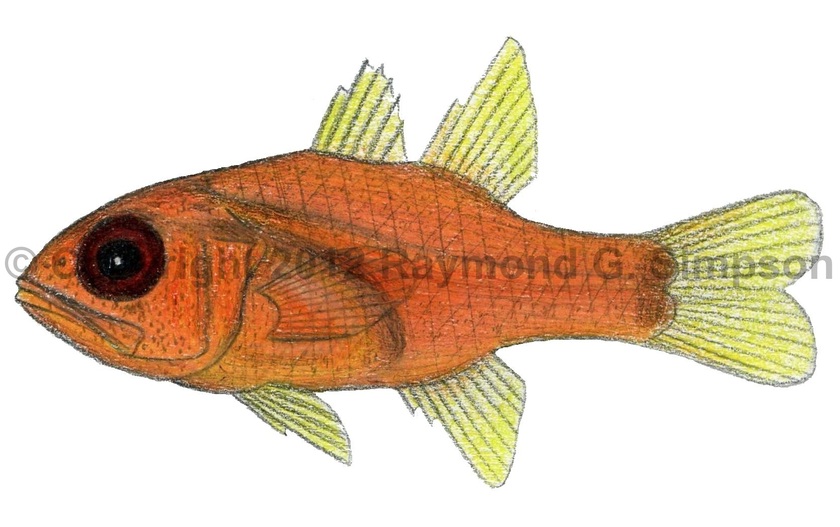
Common Name
Sawcheek Cardinalfish
Year Described
Longley, 1934
Identification
Dorsal Fin: VI, I-9
Anal Fin: II, 8
Pelvic Fin: I, 5
Pectoral Fin: 12
Gill Rakers: 3 upper, 12-14 lower
Vertebrae: 10 precaudal, 14-15 caudal
A small fish with a fairly robust and moderately compressed body. Eye is large and the snout short and rounded. Interorbital wider (8.2-10.4% SL). Mouth is fairly large and oblique, with the lower jaw slightly protruding. Both jaws, palatine, and vomer with narrow bands of villiform teeth (no canines). Preopercular edge with a heavily serrate margin. Preopercular flap does not extend past the preopercular rear margin. There are two dorsal fins. The caudal fin is slightly emarginate. Body scales ctenoid. Predorsal scales number 3-5. Scales around the caudal peduncle 16-18.
Color
Body pale orange to reddish brown, with a dense speckling of melanophores on the head and body. The pigment sometimes forms indistinct stripes on the rear body. A dark band usually present under eye. A dark diffuse blotch on the caudal peduncle. Eye is dark. The fins are pale to bright yellowish.
Size
Maximum size to 59mm SL.
Habitat
Found on coral reefs, seagrass beds, and rocky areas from 12-60m. Often found in association with sea urchins and sea anemones.
Range
S. Florida to Brazil, including the E. Gulf of Mexico and the Caribbean Sea.
References
Baldwin, C. C., Brito, B. J., Smith, D. G., Weigt, L. A. and Escobar-Briones, E. 2011. Identification of early life-history stages of Caribbean Apogon (Perciformes: Apogonidae) through DNA Barcoding. Zootaxa, 3133: 1-36.
Gon, O. 2002. Apogonidae (pp 1386-1391). In: Carpenter. 2002. The living marine resources of the Western Central Atlantic. Vol. 3: Bony fishes part 2 (Opistognathidae to Molidae), sea turtles and sea mammals. FAO Species Identification Guides for Fisheries Purposes. American Society of Ichthyologists and Herpetologists Special Publication No. 5.
McEachran, J.D. & J.D. Fechhelm. 2005. Fishes of the Gulf of Mexico. Volume 2: Scorpaeniformes to Tetraodontiformes. University of Texas Press, Austin. i-viii +1-1004.
Other Notes
Baldwin et al. (2011) provided genetic evidence of two genetic lineages under the name A. quadrisquamatus. One of these may represent a new species.